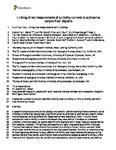Linking direct measurements of turbidity currents to submarine canyon-floor deposits
| dc.contributor.author | Maier, K | |
| dc.contributor.author | Gales, J | |
| dc.contributor.author | Paull, C | |
| dc.contributor.author | Rosenberger, K | |
| dc.contributor.author | Talling, P | |
| dc.contributor.author | Simmons, S | |
| dc.contributor.author | Gwiazda, R | |
| dc.contributor.author | McGann, M | |
| dc.contributor.author | Cartigny, M | |
| dc.contributor.author | Lundsten, E | |
| dc.contributor.author | Anderson, K | |
| dc.contributor.author | Clare, M | |
| dc.contributor.author | Xu, J | |
| dc.contributor.author | Parson, D | |
| dc.contributor.author | Barry, J | |
| dc.contributor.author | Wolfson-Schwehr, M | |
| dc.contributor.author | Nieminski, N | |
| dc.contributor.author | Sumner, E | |
| dc.contributor.author | Monterey Coordinated Canyon Experiment Team, | |
| dc.date.accessioned | 2019-05-23T08:40:26Z | |
| dc.date.issued | 2019-06-06 | |
| dc.identifier.issn | 2296-6463 | |
| dc.identifier.issn | 2296-6463 | |
| dc.identifier.other | ARTN 144 | |
| dc.identifier.uri | http://hdl.handle.net/10026.1/14197 | |
| dc.description.abstract |
Submarine canyons are conduits for episodic and powerful sediment density flows (commonly called turbidity currents) that move globally significant amounts of terrestrial sediment and organic carbon into the deep sea, forming some of the largest sedimentary deposits on Earth. The only record available for most turbidity currents is the deposit they leave behind. Therefore, to understand turbidity current processes, we need to determine the degree to which these flows are represented by their deposits. However, linking flows and deposits is a major long-standing scientific challenge. There are few detailed measurements from submarine turbidity currents in action, and even fewer direct measurements that can be compared to resulting seabed deposits. Recently, an extensive array of moorings along Monterey Canyon, offshore California, took measurements and samples during sediment density flow events, providing the most comprehensive dataset to date of turbidity current flows and their deposits. Here, we use sediment trap samples, velocity measurements, and seafloor cores to document how sand is transported through a submarine canyon, and how the transported sediment is represented in seafloor deposits. Sediment trap samples from events contain primarily fine to medium-grained sand with sharp bases, normal grading, and muddy tops. Sediment captured from the water column during the flow shows normal grading, which is broadly consistent with the initial peak and waning of flow velocities measured at a single height within the flow, and may be enhanced by collapsing flows. Flow events contain coarser sand concentrated toward the seafloor and larger grain sizes on the seafloor or in the dense near-bed layer, possibly representative of stratified flows. Although flow velocity varies, sand grain sizes in sediment traps are similar over distances of 50 km down-canyon, suggesting that grain size is an unfaithful record of down-canyon changes in maximum flow speeds. Sand transported within flow events and sampled in sediment traps is similar to sand sampled from the seafloor shortly after the events, but traps do not contain pebbles and gravel common in seabed deposits. Seabed deposits thus appear to faithfully record the sand component that is transported in the water column during sub-annual turbidity currents. | |
| dc.format.extent | 144- | |
| dc.language.iso | en | |
| dc.publisher | Frontiers Media | |
| dc.subject | submarine canyon | |
| dc.subject | sediment density flow | |
| dc.subject | turbidity current | |
| dc.subject | turbidite | |
| dc.subject | sediment trap | |
| dc.subject | Monterey Canyon | |
| dc.title | Linking direct measurements of turbidity currents to submarine canyon-floor deposits | |
| dc.type | journal-article | |
| dc.type | Article | |
| plymouth.volume | 7 | |
| plymouth.publication-status | Published online | |
| plymouth.journal | Frontiers in Earth Science | |
| dc.identifier.doi | 10.3389/feart.2019.00144 | |
| plymouth.organisational-group | /Plymouth | |
| plymouth.organisational-group | /Plymouth/Faculty of Science and Engineering | |
| plymouth.organisational-group | /Plymouth/Faculty of Science and Engineering/School of Biological and Marine Sciences | |
| plymouth.organisational-group | /Plymouth/REF 2021 Researchers by UoA | |
| plymouth.organisational-group | /Plymouth/REF 2021 Researchers by UoA/UoA07 Earth Systems and Environmental Sciences | |
| plymouth.organisational-group | /Plymouth/Users by role | |
| plymouth.organisational-group | /Plymouth/Users by role/Academics | |
| dcterms.dateAccepted | 2019-05-20 | |
| dc.rights.embargodate | 2019-6-12 | |
| dc.identifier.eissn | 2296-6463 | |
| dc.rights.embargoperiod | Not known | |
| rioxxterms.version | Accepted Manuscript | |
| rioxxterms.versionofrecord | 10.3389/feart.2019.00144 | |
| rioxxterms.licenseref.uri | http://www.rioxx.net/licenses/all-rights-reserved | |
| rioxxterms.licenseref.startdate | 2019-06-06 | |
| rioxxterms.type | Journal Article/Review |


